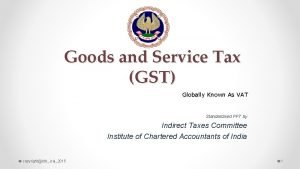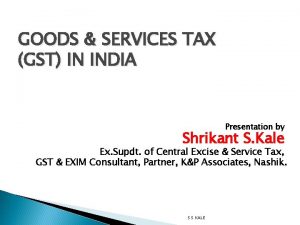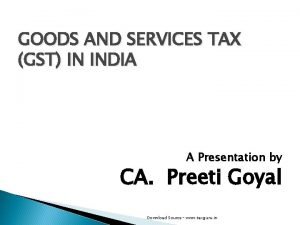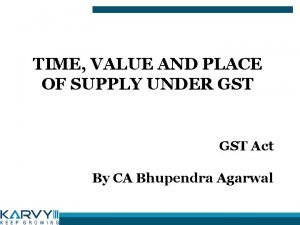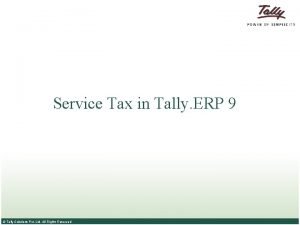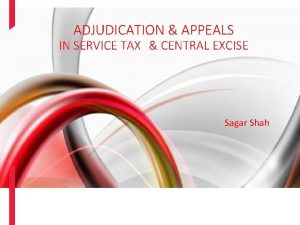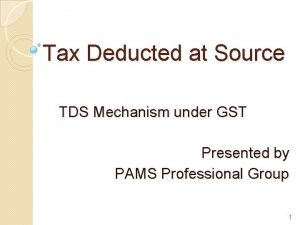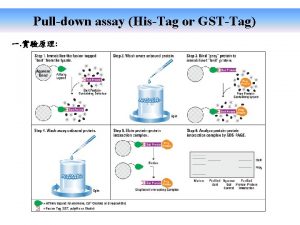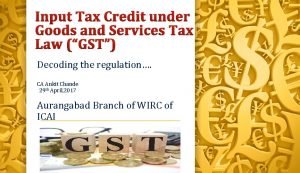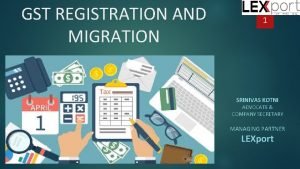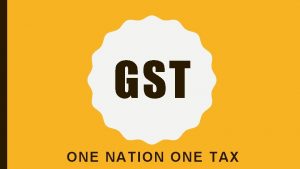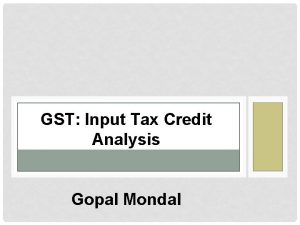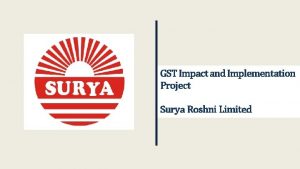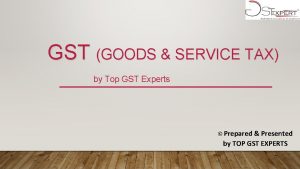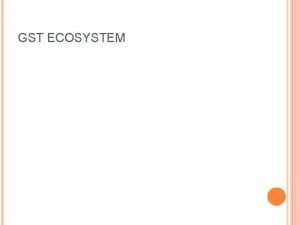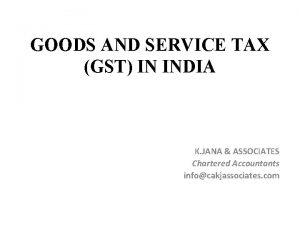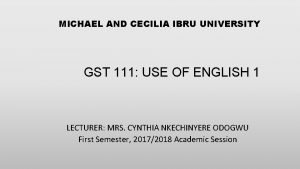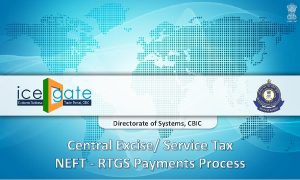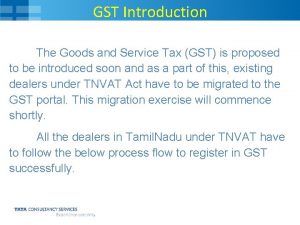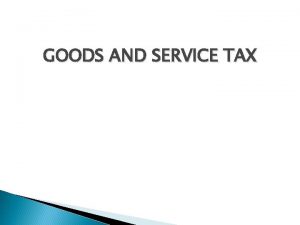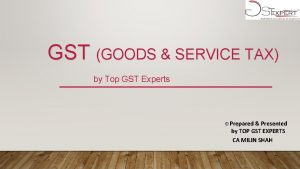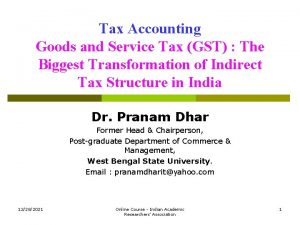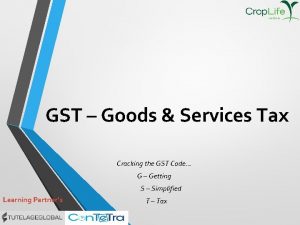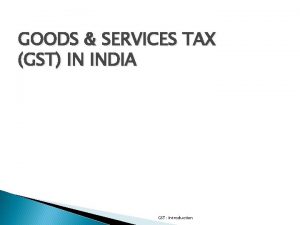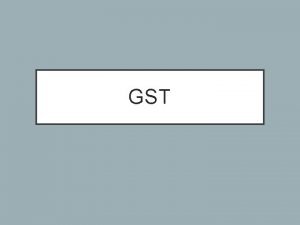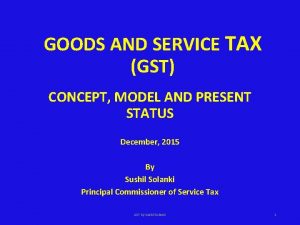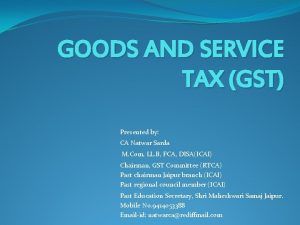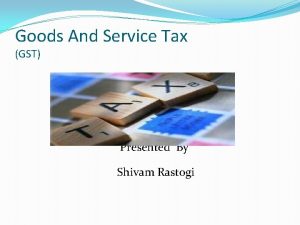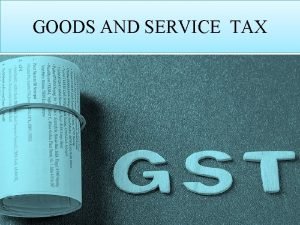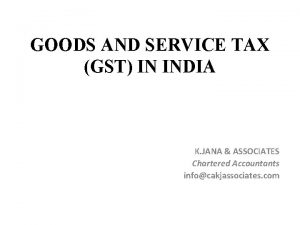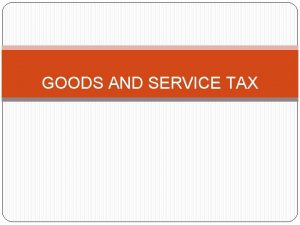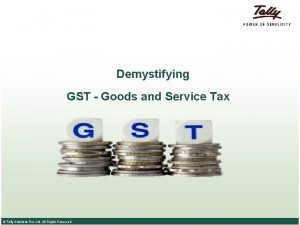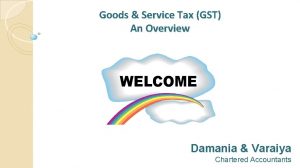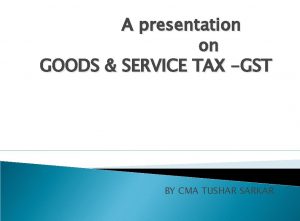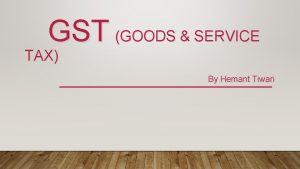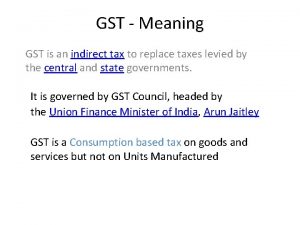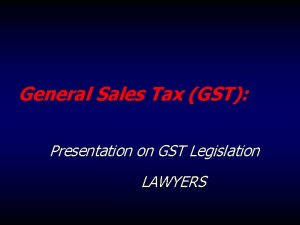Goods and service Tax GST Dr H A

































- Slides: 33

Goods and service Tax (GST) Dr. H A Raghavendra Head, Department of Commerce and Management Dr. N S A M First Grade College Bengaluru – 560 089 1

Present tax system Applicable in India TAX INCOME TAX DITECT TAX imposed on person INDIRECT TAX Imposed on Goods & services (Paid directly to Govt. ) (paid to Govt. via third person) CORPORATETAX WEALTH& GIFT TAX Central Excise Duty Commercial Tax Value Added Tax (VAT) Food Tax, Service Tax Sale tax , Surcharge and Cesses Octroi, Entertainment Tax on betting, lotteries gambling 2

Introduction to Goods and Service Tax (GST) • GST would be a very significant step in the field of indirect tax reforms in India. By amalgamating a large number of Central and State Indirect taxes into a single tax, it would mitigate cascading or double taxation in a major way and pave the way for a common national market. From the consumer point of view, the biggest advantage would be in terms of a reduction in the overall tax burden on goods, which is currently estimated to be around 25%-30%. Introduction of GST would also make Indian products competitive in the domestic and international markets. • It was introduced as the Constitution 122 nd Amendment Bill(One Hundred and Twenty Second Amendment)Act 2017. The GST is governed by GST Council and its Chairman is Union Finance Minister of India. 3

What is GST • Goods and services tax (GST) -One nation one Tax. “GST is a single Indirect Tax throughout India” to replace large number of indirect taxes levied by the central and state governments. GST would be applicable on “supply of goods and services, right from manufacturing to the consumer”. Credits of input taxes paid at each stage will be available in subsequent stage of value addition, which makes GST essentially a tax on value addition at each stage. The final consumer will thus bear only the GST charged by the last dealer in the supply chain. 4

Replacement of Various Indirect Tax Under GST The various indirect taxes levied by centre and state Government subsumed under GST Central Government- Central Excise Duty Central Sales Tax (CST) Service tax Additional duties of excise-Textile Additional customs duties (CVD) Special duties of customs (SAD) Surcharge and Cesses Duty of excise- medical- State Government Value Added Tax (VAT), Central Sales Tax State cesses and surcharges Entertainment Tax Entry Tax (all forms) Octroi Luxury Tax Advertisement taxes Purchase Tax on betting, lotteries & gamblings 5

Commodities Kept out side the preview of GST (or GST May not Replace following Transactions) • Sin goods-Alcohol for human consumption and Cigarette • Petroleum products-petroleum crude, motor sprit (petrol), high speed diesel, natural gas and aviation turbine fuel and electricity • Duties and Tax-Basic custom duty, Export duty, Road tax, passenger tax, property tax, toll tax, stamp duties (the existing tax system will apply) 6

Principles for subsuming all Indirect Tax Under GST • It Should be Indirect Tax-Primarily in the nature of Indirect Tax either supply of goods or services • Part of Transaction-Subsumed Indirect Tax should be part of transaction chain which commences with import/manufacture/production of goods or services • Free flow of Tax credit-Subsumed Tax should result in free flow of tax credit in intra and interstate level 7

Salient features of GST 1. 2. 3. 4. 5. 6. GST would be applicable on “supply” of goods or services- as against the present concept of tax on the manufacture of goods or on sale of goods or on provision of services. It is Based on consumption Taxation-GST would be based on the principle of destination based consumption taxation as against the present principle of origin-based taxation. It replaces Indirect Tax-GST subsumed large number of Indirect Tax levied by Central and State Govt. It would be a dual GST -with the Centre and the States Govt. simultaneously levying it on a common base. Centre would be called Central GST (CGST) and that to be levied by the States [including Union territories with legislature] would be called State GST (SGST). Union territories without legislature would levy Union territory GST (UTGST). An Integrated GST (IGST) -would be levied on inter-State supply (including stock transfers) of goods or services. The Centre would collect this so that the credit chain is not disrupted Import of goods and services -would be treated as inter-state supplies and would be subject to IGST in addition to the applicable customs duties 8

GST RATES • Rates levied-CGST, SGST /UTGST& IGST would be levied at rates to be mutually agreed upon by the Centre and the States under the aegis of the GSTC. Four main slab ranging from 5% to 28% – – – Four rates are- 5%, 12%, 18% and 28%. Essential items (Grains) would be taxed at 0% The lowest 5% rates would be for commonly used items 12% and 18% would be two standard rates of GST 28% rate applicable on luxury items. There is a special rate of 0. 25% on rough precious and semi-precious stones and 3% on gold. 9

Rate Classifications for Goods (0%) Food Grains Cereals Milk , curd Jaggery lassi Common Salt Vegetables eggs , Honey, Unpacked panner, 5% 12% 18% 28+cess Sugar, Coffee Tea, Drugs & Medicine Edible Oil Sweets, Raisin Cashew, spice Dom. LPG pds Kerosen Coal, Ag batti Packed panner Apparels 1000) Footwear<500 Fruit Juices Fertilizers Ghee butter Almond Umbrella Mobile, pickle Processed food , Jam, Computer Capital Goods Industrial Intermediaries Hair Oil, Soap Toothpaste Computer monitor < 17 Inc Printer, CCTV Toiletries Soup, Pasta Ice-cream Staplers Air Conditio ner Refrigera tors Small Cars (1% / 3% Cess) Luxury Cars, high end motor cycle, cigarettes (15% Cess) • GST rate on pearls, precious or semi-precious stones, diamonds (other than rough diamonds), precious metals (like gold and silver), imitation jewellery, coins – 3%. • GST rate on rough diamonds – 0. 25%. 10

Rate Classifications for Services Exempt(0%) 5% 12%-18% 28% Education. Healthcare. Residential accommodation. Children’s Drawing & Colouring Books Hotel / Lodges with tariff below INR 1000 Goods transport. Rail Tickets (other than sleeper class). Economy class air tickets. Cab aggregators. Selling space for advertisements in print media. Works contract. Business Class air travel. Telecom services. Financial services. Restaurant services. Hotel / Lodges with tariff between INR 1000 and 5000. Cinema tickets. Betting. Gambling. Hotel / Lodges with tariff above INR 5000. 11

Advantage/Benefit of GST… For Business and Industries 1. 2. 3. 4. 5. 6. Easy compliance: All tax payers services such as registrations, returns, payments etc would be available to the taxpayers online, which would make compliance easy and transparent Uniformity of tax rates and structure: GST will replace all Indirect Taxes levied by central and state Govt. and ensure that indirect tax rates and structures are common across the nation, thereby increasing certainty and easy of doing business. Removal of cascading effect- Tax on tax will remove and apply single tax (GST) on supply of goods and services right from manufacturing to consumer throughout the value chain and across boundaries of State. In ensures easy for running business. Improved Competitiveness- reduction in the transaction costs of doing business this would eventually lead to an improved competitiveness for the trade and industry. Gain to manufacturers and exporters- subsuming all indirect taxes and complete and comprehensive set off of input goods and services would reduce the cost of locally manufactured goods and services. This will ensure better goods to be manufactured with in India are become more competitive and cheaper than imported goods, and increasing competitiveness of Indian goods and services in the international market and give boost to Indian export. Better movement of goods- Removal of check post point for checking flow of goods from form one state to another state. So flowing of goods easy form state to state

Advantage/Benefit of GST… For Central and State Government 1. 2. 3. 4. 5. Simple and easy to administer: Backed with a robust end-to end IT system. GST would be simpler and easier to administer than all other Indirect taxes. Better control of leakage: GST will result in better tax compliance due to a robust IT infrastructure(self policy system inbuilt in GST). Due to seamless transfer of input tax credit from one stage to another in the chain of value addition, there is an inbuilt mechanism in the design of GST that would incentivize tax compliance by traders. Higher Revenue efficiency-GST is expected to decrease the cost of collection of tax revenues of the Govt. and will therefore, lead to better tax collection and ensure higher revenue efficiency. GST will reduce flow of Block money- money on which tax is not paid to Govt. by under reporting their income. Through GST Credit of input tax on each stages is available. So avoiding tax is not possible One India one Market- GST will facilities Make in India by making Continue 13 one India one market by removing multiple taxes

Advantage/Benefit of GST For the Consumer 1. 2. Single and transparent tax proportionate to the value of goods and services: under GST, there would be only one tax from the manufacturer to the consumer, leading to transparency of taxes paid to the final consumer. Relief in overall tax burden: because of efficiency gains, prevention of leakages, and input tax credit seamless flow between the manufacturer, retailer and service supplier, the overall tax burden on most commodities will come down, Hence, the final price of goods is expected to be lower which will benefit to consumers. For e. g. Impact of GST on Common man Current Indirect Tax regime Indirect Tax on goods-27%-32% in general Indirect tax on service-15% of cost of service the Maximum rate around 47% (32+15) GST system will reduce the tax burden on common man the maximum rate is 28% (47 -28 (max GST=19%) 14

Type of GST/GST Administered in India • • Dual GST model- India will adopt dual GST Model because India is a federal country both centre and state have been assigned the power to levy and collect taxes through appropriate legislation. Dual GST will Therefore, keeping with the constitutional requirement of fiscal federation. Both centre and state will simultaneously levy GST on a common tax base. 1. Central GST (CGST) - The GST to be levied by centre on intra-state (Transactions made within a single state) supply of goods and services would be called CGST. The input tax credit of CGST would be available for discharging the CGST liability on the output at each stage. 2. State GST (SGST)-The GST to be levied by state Govt. called state GST (SGST). The input tax credit of SGST would be available for discharging the SGST liability on the output at each stage. No cross utilization of credit would be permitted Integrated GST- IGST will be levied and administered by centre on every Interstate (one state to another state) supply of goods and services under the Article 269 A (1) of constitution. GST is a consumption based tax, therefore, taxes are paid to the state which the goods or services are consumed not the state in which they were produced. 15

Input TAX Credit System (ITC) • Credit of CGST paid on inputs may be used only for paying CGST on the output and • the credit of SGST/UTGST paid on inputs may be used only for paying SGST/UTGST. (In other words, the two streams of input tax credit (ITC) cannot be cross utilized ) • input tax credit (ITC) of IGST allowed for payment of IGST, CGST & SGST/UTGST in that order. ITC of CGST cannot be used for payment of SGST/UTGST and vice versa. (Exceptional) Inter-State supplies for payment of IGST -The credit would be permitted to be utilized in the following manner: ITC of CGST allowed for payment of CGST & IGST in that order; ITC of SGST allowed for payment of SGST & IGST in that order; ITC of UTGST allowed for payment of UTGST & IGST in that order; 16

Dual GST within State: Working example SGSTpaid RS 9 Timber Maker SGSTpaid RS 9 (Rs 18 -Rs 9 ICT) A CGSTpaid RS 9 SGST 9% Furniture Maker Furniture retailer B CGSTpaid RS 9 (Rs 18 -Rs 9 ICT) SGSTpaid RS 9 (Rs 27 -Rs 18 ICT) C Final consumer CGSTpaid RS 9 (Rs 27 - Rs 18 ICT) CGST 9% Tax Invoice A Cost of Goods = Rs. 100 SGST @ 9% = Rs 9 CGST@ 9% = Rs. 9 Total = Rs. 118 Tax Invoice B Cost of Goods = Rs. 200 SGST @ 9% = Rs 18 CGST@ 9% = Rs. 18 Total = Rs. 236 Tax Invoice C Cost of Goods = Rs. 300 SGST @ 9% = Rs 27 CGST@ 9% = Rs. 27 Total = Rs. 354 17

IGST Model: Working example State Y State X SGST paid RS 9 State Border SGSTpayable 27 Less: IGST ICT 9 SGST paid 18 SGST 9% Timber Maker CGSTpaid RS 9 A Furniture Maker IGSTpayable Rs 36 Less: CGSTICT Rs 9 Less : SGSTICT RS 9 IGSTpaid in cash 18 B Furniture retailer Final consumer C CGSTpay able RS 27 less: CGST ICT Rs 0 IGST Rs 27 CGST=0 CGST 9% IGST 18% Tax Invoice A SGST 9% Tax Invoice B Cost of Goods =Rs. 100 SGST@ 9% = Rs 9 CGST@ 9% = Rs. 9 Cost of Goods = Rs. 200 IGST @ 18% = Rs. 36 Total = Rs. 118 Total = Rs. 236 Tax Invoice C Cost of Goods = Rs. 300 SGST@ 9% = Rs 27 CGST@ 9% = Rs. 27 Total = Rs. 354 18

How will Imports be taxed Under GST • The additional duty of excise or CVD and the special additional duty or SAD presently being levied on imports will be subsumed under GST. As the explanation to clause(1) of article 269 A of the constitution. IGST will be levied on all imports goods and services. 19

Registration Procedure under GST 1. Existing dealers: Existing VAT/Central excise/ Service TAX payers will not have to apply fresh for registration. but they mandatory migrate from existing system to GST if their turnover Rs 20 lakhs and more in an annum 2. New Dealers: single application to be filled online for registration under GST 3. Registration No. : will be PAN based and will serve the purpose for centre and state 4. Unique ID: Each dealer to be given unique ID GSTIN 5. Approval: Deemed approval within three days 6. Unified application: unified application for both tax authorities 20

Return filing procedure under GST 1. Common return: Common return would serve the purpose of both centre and state Govt. 2. Forms: there would be eight forms provided for inn the GST business processes for filing returns. Most of the average taxpayers would be using only four forms for filing their returns. These returns are- returns for supply, return for purchases, monthly return and annual return 3. Small tax payer: small tax payer who have opted composition scheme shall have to file return on quarterly basis. 4. On line filing: Filing of return completely on line 5. Tax paid: All taxes should be paid online by using internet banking, RTGS, NEFT , Debit card, Credit card etc. , 21

Goods and Services Tax Network (GSTN)/ IT be used for GST… • Goods and Services Tax Network (GSTN) is a non-profit organization formed to create a platform for all the concerned parties i. e. stakeholders, government, taxpayers to collaborate on a single portal. The portal will be accessible to the central government which will track down every transaction on its end while the taxpayers will be having a vast service to return file their taxes and maintain the details. The IT network will be developed by private firms which are being in tie up with the central government and will be having stakes accordingly. The known authorized capital of GSTN is 10 crore in which Central Government holds 24. 5 percent of shares while the state government holds 24. 5 percent and rest with private banking firms Continue 22

1. 2. 3. 4. GST Mechanisms/IT be Used. . Common return Filing-Electronic filing of returns by different class of persons at different cut-off dates. GSTR-1, details of outward supplies by the 10 th of following month, GSTR-2, -details of inward supplies by 15 th of following month & GSTR-3 monthly return 20 th of the following month. There would no manual filing of return. All Mismatched returns would be auto generated, and there would be no need for manual interventions Modes of Payment of Tax- All taxes can also be paid on line. The Various modes of payment of tax available to the taxpayer including internet banking, debit / credit card and National Electronic Funds Transfer (NEFT) / Real Time Gross Settlement (RTGS). Obligation-Obligation on certain persons including Govt. departments, local authorities and Govt. agencies, who are recipients of supply, to deduct tax at the rate of 1% from the payment made or credited to the supplier where total value of supply, under a contract, exceeds two lakhs and fifty thousand rupees (Rs. 2. 5 lac). Refund of Tax-Refund of tax to be sought by taxpayer who has borne Continue 23 the incidence of tax within two years from the relevant date.

5. 6. 7. 8. 9. GST Mechanisms/Process… E-commerce operators-Obligation on electronic commerce operators to collect ‘tax at source’, at such rate not exceeding one per cent. (1%) of net value of taxable supplies, out of payments to suppliers supplying goods or services through their portals. Registered person-System of self-assessment of the taxes payable by the registered person. If the turnover Rs 20 lakhs & above per annum registration Audit-Audit of registered persons to be conducted in order to verify is mandatory for a trader compliance with the provisions of Act. Raising demand is three years-Limitation period for raising demand is three (3) years from the due date of filing of annual return or from the date of erroneous refund for raising demand for short-payment or non-payment of tax or erroneous refund and its adjudication in normal cases. Raising demand is Five years-Limitation period for raising demand is five (5) years from the due date of filing of annual return or from the date of erroneous refund for raising demand for short-payment or non-payment of tax or erroneous refund and its adjudication in case of fraud, suppression or willful mis-statement. continue 24

GSTMechanisms/Process… 11. power of inspection-Officers would have restrictive powers of inspection, search, seizure and arrest. 12. Arrears of Tax recovering-Arrears of tax to be recovered using various modes including detaining and sale of goods, movable and immovable property of defaulting taxable person. 13. GST Appellate tribunal-Goods and Services Tax Appellate Tribunal would be constituted by the Central Government for hearing appeals against the orders passed by the Appellate Authority or the Revisional Authority. States would adopt the provisions relating to Tribunal in respective SGST Act. 14. Penalties provision-Provision for penalties for contravention of the provision of the proposed legislation has been made. 15. Advanced ruling authority-advance Ruling Authority would be constituted by States in order to enable the taxpayer to seek a binding clarity on taxation matters from the department. Centre would adopt such authority under CGST Act. 16. An anti-profiteering clause has been provided- in order to ensure that business passes on the benefit of reduced tax incidence on goods or services or both to the consumers. 17. Elaborate transitional provisions have been provided- for smooth transition of existing taxpayers to GST regime 25

Sector Wise Impact of GST… • Automobiles -The effective tax rate in the sector currently ranges between 30 per cent and 47 per cent. • Highlights 1. 2. 3. 4. On implementation of GST, the tax rate is expected to oscillate between 18 -28 % It is expected to drive overall demand reduce cost for the end user by about between 5 -12 per cent. The transportation time and the overall cost will be reduced, as the goods will be transferred from one state to another by easily surpassing various octroi and checkpoints. In addition to this, the cost for the logistics and supply chain inventory will be curtailed by almost 30 -40 per cent. • Impact -In a long run, GST is expected to remain positive for automobile sector. continue 26

Sector Wise Impact of GST… • Consumer Durables (FMG) -The current tax rate for the sector ranges between 7 per cent and 30 per cent. • Highlights 1. 2. 3. 4. The implementation of GST will essentially benefit companies, which have not availed tax exemptions in the past. It will lead to the reduction of the price gap between the organised and unorganised sector. The warehouse / logistics costs across the operational and non-operational segments will be curtailed. This will improve the operational profitability The 7 th Pay Commission is also expected to boost demand fund inflow in the consumer durables sector by the end of the year. • Impact -The impact may remain neutral or negative, specifically for companies, which either enjoy tax exemptions or fall under the concessional tax bracket. • Key Beneficiaries -CGCE, Havells, Voltas, Blue Star, Bajaj Electricals, Symphony, Hitachi. Continue 27

Sector Wise Impact of GST… • Furnishing and Home Decor -Currently, the effective tax rate for the sector ranges above 20 per cent. • Highlights 1. • • After the implementation of GST, paints and other construction chemicals companies will benefit from lower tax rate. 2. At present, the market share for the organised sector is about 65 -70 per cent. Effective tax correction practices under the GST regime will ensure that the price difference amongst the unorganised sector and the organised sector is narrowed. This will improve opportunities for the organised sector. 3. The overall cost and competitiveness in products such as like ceramic tiles, faucets, sanitary ware and plywood & laminates manufacturer will be curbed. Impact -Implementation of GST is expected to bring the unorganised sector under a uniform tax base and improve growth opportunities for the organised sector. Key Beneficiaries -Asian Paints, Berger Paints, Kansai Nerolac, Akzo Nobel, BASF India, Pidilite, HSIL, Cera Sanitaryware, Greenply, Greenlam Industries, H&R Johnson (Prism Cements), Kajaria Ceramics. continue 28

Sector Wise Impact of GST… • Logistics • Highlights 1. The implementation of GST will lead to lower transit time and thereby generate higher truck utilisation. This will boost demand for high tonnage trucks and lead to overall reduction in transportation costs. It will facilitate seamless inter-state flow of goods, which is expected to directly accelerate demand for logistics services. • Impact -The logistics sector is largely fragmented and comprises many unorganized players. Several players in the unorganised sector avoid tax, which generates a cost gap between them and the organized players. With the GST coming into picture, we expect an overall positive impact, with a reduction in the cost competitiveness as all the players will be brought under a uniform tax base, thereby improving growth opportunities for the organized players. • Key Beneficiaries -VRL Logistics, GATI, Blue Dart, Transport Corporation of India, Snowman Logistics. continue 29

Sector Wise Impact of GST… • CEMENT -Currently, the tax on cement ranges between 27 per cent and 32 per cent. • Highlights 1. 2. The tax rate for the cement sector is expected to decline to 18 -20 per cent under the GST regime. This is expected to lead to savings in the transportation cost, which currently comprises up to 20 -25 per cent of total revenue. Thereby, overall realizations of cement companies will substantially improve post GST rollout. • Impact -The impact of GST will be positive, as the companies will also be able to save on their logistic costs, due to rationalization of warehouses and lower transportation costs (due to decline transit time). • Key Beneficiaries -ACC, Ultratech, JK Cement, Shree Cement. continue 30

Sector Wise Impact of GST… • Entertainment -We have divided in two main categories i. e. Multiplexes and Media. We expect a significant impact on both the sectors after implementation of GST. • Multiplexes -This category attracts different taxes such as service tax, entertainment tax and VAT among others. Currently, the effective tax ranges between 22 -24 per cent. Highlights 1. It is expected GST tax rate will trickle down to 18 -20%. 2. Reduction in taxes will lead to an increase in average ticket price (ATP) and higher revenue. 3. There exist several challenges pertaining to: Availability of limited credit for service tax paid on lease rentals, maintenance cost, advertisements, and security charges. No credit is available on the taxes paid on capital expenditure. The VAT credit on available on the purchase of F&B can be offset against VAT liability on F&B sales. Entertainment tax rate on box office collections ranges between 22 -24 per cent and the same is not convertable against any input taxes. 4. These will be addressed after the implementation of GST. Impact -The overall impact is expected to be positive and the margins of players are expected to increase by 250 -350 bps. Key Beneficiaries -PVR, Inox Leisure. • • • Continue 31

Sector Wise Impact of GST… • MEDIA -Currently, the effective tax rate for the DTH providers ranges between 20 -21 per cent (this includes service tax of 14 per cent and entertainment tax of around 5 -7 per cent). The effective tax range for the broadcasters is around 14 -15 per cent. • Highlights – 1. On implementation of GST, a blanket rate of around 18 -20 per cent will apply, which is lower than current tax rate for the DTH provider and higher for the broadcaster. 2. Print media-Currently the news and print sector is exempted from all indirect taxes. Post GST, we expect concessional rates to be introduced in this sector. • Impact -Implementation of GST will be healthy for the DTH providers and downbeat for broadcasters. The overall impact on the news and print sector will be neutral • Key Beneficiary -Dish TV, Marginally Negative: Zee, Sun, HT Media and Jagran Prakashan continue 32

Sector Wise Impact of GST… • PHARMA -Currently, the sector enjoys various location-based tax incentives. The effective tax rate (excise duty) for most companies is much below the statutory tax rate (6 per cent). • Highlights 1. The concessional tax bracket for the sector is expected to continue. 2. The existing tax exemptions will continue until expiry of the tax exemption period. Going forward it will be difficult to bring forth the new exemptions. 3. GST is also expected to address inverted duty structure and lower logistic costs for the sector. • Impact -It is expected remain neutral for the pharmaceutical sector 33
 Product classifications
Product classifications Goods and service tax
Goods and service tax Before gst tax structure in india
Before gst tax structure in india Gst conclusion
Gst conclusion Progressive tax examples
Progressive tax examples Merit good vs public good
Merit good vs public good Public goods dan private goods adalah
Public goods dan private goods adalah Ralphs annual income is about $32 000
Ralphs annual income is about $32 000 Product line decisions
Product line decisions Philosophy and human existence gst 113
Philosophy and human existence gst 113 Time and value of supply under gst
Time and value of supply under gst Laxmikumaran and sridharan gst
Laxmikumaran and sridharan gst Service tax tally erp 9
Service tax tally erp 9 Cbic service tax login
Cbic service tax login What is utr in gst
What is utr in gst Gst deduction at source
Gst deduction at source Annexure b for gst refund
Annexure b for gst refund Gst pulldown assay
Gst pulldown assay Gst 105
Gst 105 Section 18(1)(c) of gst
Section 18(1)(c) of gst Srinivas kotni
Srinivas kotni Introduction of gst
Introduction of gst Section 18(1)(c) of gst
Section 18(1)(c) of gst Negative list of gst
Negative list of gst Gst rates on services pdf
Gst rates on services pdf Gst ecosystem meaning
Gst ecosystem meaning Gst 101
Gst 101 Concept of gst
Concept of gst Eway bill invalid login credentials error
Eway bill invalid login credentials error Gst 111 communication in english
Gst 111 communication in english Impact of gst on construction industry
Impact of gst on construction industry Conclusion on gst
Conclusion on gst Gst matchup chart
Gst matchup chart Cbicpay
Cbicpay

